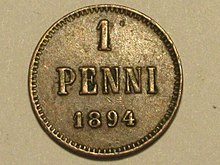Finnish mark
| Finnish mark | |
|---|---|
| Country: |
|
| Subdivision: | 100 Pfennig (Penniä) |
| ISO 4217 code : | FIM |
| Abbreviation: | mk or Fmk |
|
Exchange rate : (fixed) |
1 EUR = 5.94573 FIM |
The Finnish mark ( Finnish markka , Swedish mark , German also called Finnmark ) is the former currency unit of Finland .
The sub-unit was the pfennig ( Finnish penni , pl. Penniä ; abbreviation: p ), 100 pfennigs resulted in one mark. The abbreviation used was mk or according to ISO 4217 FIM.
Monetary history
As finds have shown, trade was carried out in Finland as early as Roman times. Copper Roman coins were used for this. In the early Middle Ages, as in the rest of Europe, the silver currency became common. The money came to Finland through trade connections. In the 13th century, the Swedes occupied Finland and introduced the Swedish monetary system. The first known mint was established in Turku , the largest city in Finland at the time , which minted coins for the Finnish part of the kingdom on behalf of the Swedish king. These were ore , mark and taler coins .
After Finland became a Grand Duchy under the rule of the Russian Tsar as a result of the Russo-Swedish War in 1809 , the Russian currency system was introduced. The ruble was used , divided into 100 kopecks . In 1811 the Tsar approved the establishment of the Finnish Bank ( Suomen Pankki / Finlands Bank). One of its tasks was to collect the circulating Swedish money, so that the Russian silver ruble prevailed in everyday life until around 1840 .
During the Crimean War , paper money was no longer redeemed for silver in Russia , so Finland experienced paper money inflation. The inflation indeed was only 20%, was the Finns, however, too much. The Finnish bank could have exchanged its own paper money for silver, but was obliged to redeem the Russian money as well. A request by Finnish politicians to be allowed to return to the silver currency was not granted by the tsar. Fabian Langenskiöld was able to convince the tsar that the silver ruble is too large a unit for a country as small as Finland. He was therefore given permission to print his own quarter-ruble notes. These were put into use on April 1, 1860 under the name "Markka". Johan Vilhelm Snellman achieved that this markka could be linked to silver. Coin production began in 1864, now in Helsinki, which the Russians have developed into the capital . The official introduction took place the following year. The silver mark, divided into 100 pennies, became the Finnish currency, the silver ruble was still valid. Since the paper ruble was still in use in Russia, the silver ruble was hoarded in the money boxes. The Finnish coins prevailed in general payment transactions .

In the 1870s, the silver price slipped compared to gold in general, which is why many countries switched to the gold currency . When the Tsar approved the currency change for Finland in 1878, the Finnish politicians introduced a gold currency that was in relation to the French franc , while in Russia the silver ruble was still officially used and the paper ruble unofficially. Since the conversion of the currency had been decided by the Finnish parliament, the tsar could no longer reverse the entire process; because he was not allowed to change Finnish laws on his own.
In 1886 the Finnish bank received permission to issue its own banknotes . These were in circulation from 1889. In 1915, like many other banks in Europe, the guarantee that banknotes could be exchanged for gold was lifted.
In the course of the Russian October Revolution , a brief and violent civil war broke out in Finland between pro-Russian sympathizers and Finnish nationalists, which the latter clearly won. A coin set of 1, 5 and 10 pennies made of copper and 25 and 50 pennies made of silver with a different coat of arms is known from this period .
On December 6, 1917 Finland declared its independence and became an independent republic. Initially, independence did not change anything about the currency . However, new coins were issued.
The Åland Islands were still left after a decision by the League of Nations in the territory of Finland on 24 June 1921st Finland had to undertake to grant the almost exclusively Swedish-speaking population extensive rights of self-government. The Finnish mark continued to be used as a means of payment .
In 1926, with the return of the link to the gold standard, attempts were made to stabilize the currency. Due to the strong fluctuations in the price of the precious metal, the experiment was given up five years later. Gold coins of 100 and 200 Markka are known from this period .
During the Second World War there were a number of emergency coins made of copper or iron . In the Peace of Paris in 1947, Finland lost large areas to the Soviet Union, which resulted in a smaller currency area .
In 1948 Finland joined the International Monetary Fund (IMF, ( English IMF )) and the World Bank . The Finnish mark was included in the system of fixed exchange rates pegged to the US dollar and gold. This did not lead to the hoped-for stabilization; rather, the inflationary tendencies intensified. In the late 1950s, the currency became fully convertible again .
Devaluation 1963
Due to the continuing inflation, a devaluation was necessary on January 1, 1963 , whereby two zeros were deleted and new money was issued, which was valid for a time alongside the old banknotes and coins .
At the beginning of the 1970s, the Finnish Bank tried not to align the external value of the Finnish currency with the value of gold as it had before. She used a procedure common at the time, that of the shopping basket index, in order to be able to control fluctuations in the exchange rate . As in Central Europe, however, inflation remained constant, and by today's standards, relatively high.
At the end of the 1970s, the 1 penny coin was abolished and the 5 penny coin ten years later, after being made from aluminum for a while. Most recently, as everywhere in Scandinavia, amounts were rounded to smooth five-penny sums and, from 1990, to ten-penny sums. In 1986 the issue of counterfeit-proof banknotes began.
In 1991 the external value of the Finnish currency was defined in relation to the ECU . In 1995 Finland became a member of the EU and on October 14, 1996 it joined the European exchange rate system .
In 1999 the euro was introduced as a book currency with fixed exchange rates . The official conversion rate was set at 5.94573 marks = 1 euro. From January 1st, 2002 the new coins and banknotes were issued. The Finnish bank exchanged the notes and coins that were last valid before the introduction of the euro into euro by the end of February 2012. Since then, they have only been a collector's item.
Conversion rates
- 1963 1 Mk new / 100 M old corresponded to 1.25 DM,
- 1978 1 Mk was equivalent to DM 0.48,
- In 1990 the value fell to 0.43 DM and
- 1995 to 0.32 DM
- In 1999 the exchange rate for 1 Mk was set at 0.328947 DM.
Overview of the coins and banknotes in circulation since 1918
The following coins and banknotes have been in circulation since 1918 :
In the 1920s, 1, 5 and 10 pfennig coins made of copper and 25, 50 pfennig coins and 1 mark coins made of copper nickel were minted. A 25-pfennig note is known from 1918. The gold standard was documented in 1926 by a 100 and a 200 mark piece.
Due to currency devaluation, the 1-pfennig coin was dispensed with from 1924. In the 1930s, the 5 and 10 pfennig coins in copper, the 25, 50 pfennig coins and 1 mark coins in copper nickel continued to be minted in the same way. In addition, from 1928 there were new 5 and 10 and from 1931 20 mark coins made of an aluminum bronze alloy .
In the 1940s, the aftermath of World War II was clearly felt. The 5-pfennig coin was still minted in copper until 1943 and then discontinued. The 10, 25 and 50 pfennig pieces were made in copper until 1943, then in iron. During these years, the 1-mark piece was available in alternating designs in both copper and iron; the 5-mark piece was minted in brass . 10, 20 and 50-mark notes from 1939 are known of banknotes.
By 1953, inflation had progressed so far that the market values took over the function of the penny coins and were minted in the same size as these. The 1 and 5 mark coins were made from nickel-plated iron, the 10, 20 and 50 mark coins from aluminum bronze. The 20-mark piece took on the function of the 25-pfennig piece. In addition, 100 and 200 mark coins containing silver were produced from 1956 to 1959 and 1960. The following banknotes were in circulation: 100, 500, 1,000, 5,000 and 10,000 marks.
After the currency changeover in 1963, the new 1 and 5 pfennig coins were minted again in copper , the 10, 20 and 50 pfennig coins in aluminum bronze and the 1 mark coin in an alloy with a low silver content. The sizes corresponded exactly to those of the mark pieces before the conversion, so that the coins could be used next to each other with almost no problems. In 1967, a was commemorative coin from silver hook.
In the 1970s the 1-pfennig piece was made of aluminum , the 5-pfennig piece was made from copper as before, and the 10, 20 and 50-pfennig piece was made from aluminum bronze as before. The 1-mark piece was now made from cupronickel. There was also a 5-mark piece made of aluminum bronze. Since 1970 there have been other special silver coins. Since 1963 the banknotes have been denominated 1, 5, 10, 50 and 100 marks. From 1975 to 1980 modernized 10, 50 and 100 mark notes and a new 500 mark note appeared.
In the 1980s, the 1-pfennig coin was again dispensed with. The 5 and 10 pfennig coins as the smallest denominations were now made of aluminum, the 20 and 50 pfennig coins were made of aluminum bronze and the 1 mark was also made of copper nickel. The 5-mark piece was minted in the same alloy in a different drawing. In 1986 new banknotes were issued for 10, 50, 100, 500 and 1,000 marks.
In the 1990s, the 5-pfennig piece was dispensed with and the 10-pfennig piece was minted as the smallest denomination in cupronickel. The production of the 20-pfennig piece was discontinued. A 50-pfennig piece was minted with a new drawing, the 1-mark piece was minted from aluminum bronze with a new drawing from 1993. A new 5 and an additional 10 mark piece were issued. The banknote series was supplemented in 1993 by a 20-mark note.
At the beginning of 2002 the mark was replaced by the euro.
Banknotes of the last series before the introduction of the euro
| Face value | image | portrait | |
|---|---|---|---|
| 10 marks |

|

|
Paavo Nurmi (1897–1973), athlete |
| 20 marks |
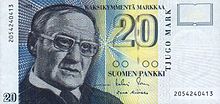
|
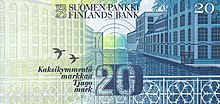
|
Väinö Linna (1920-1992), author |
| 50 marks |
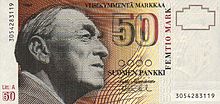
|

|
Alvar Aalto (1898–1976), architect and designer |
| 100 marks |

|
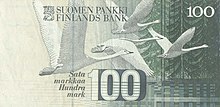
|
Jean Sibelius (1865–1957), composer |
| 500 marks |

|
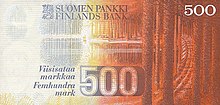
|
Elias Lönnrot (1802–1884), writer, philologist and doctor |
| 1000 marks |

|
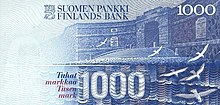
|
Anders Chydenius (1729–1803), pastor, politician, economist and philosopher |
Coins
(1990-1993)
- 10 Pfennig (kymmenen penniä / tio penni) - lilies of the valley
- 50 Pfennig (viisikymmentä penniä / femtio penni) - bear
- 1 Mark (yksi markka / en mark) - heraldic lion of Finland
- 5 Mark (viisi markkaa / fem mark) - Saimaa ringed seal
- 10 Mark (kymmenen markkaa / tio mark) - capercaillie
See also
Web links
- History of the Finnish Mark ( Memento from February 20, 2008 in the Internet Archive )
- Chester, Krause, Mishler: Standard Catalog of world coins, 1991
- Backnanger Kreiszeitung: History on stamps and coins, article from February 7, 2002.
- Historic banknotes from Finland

